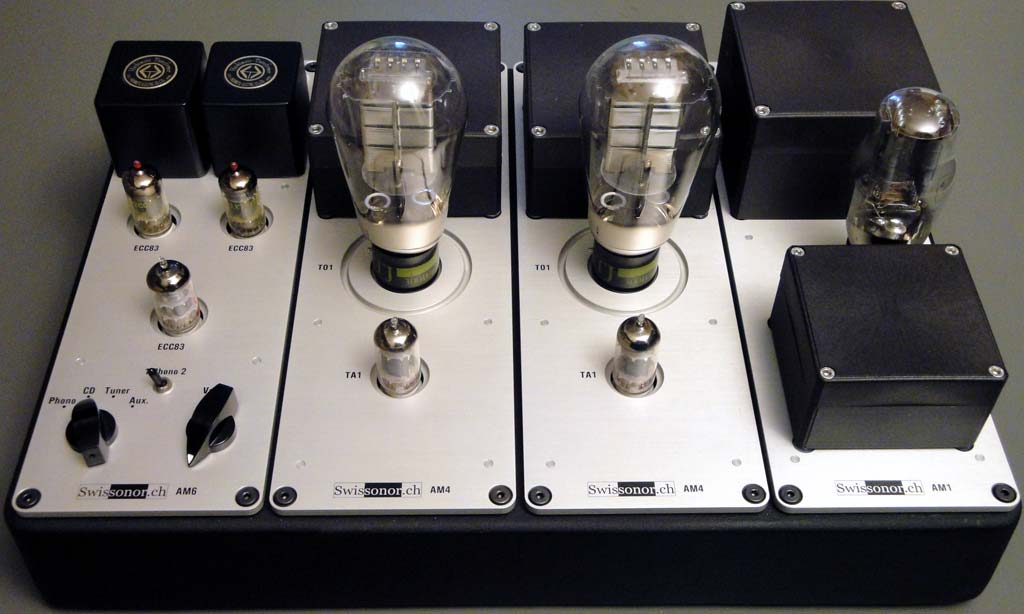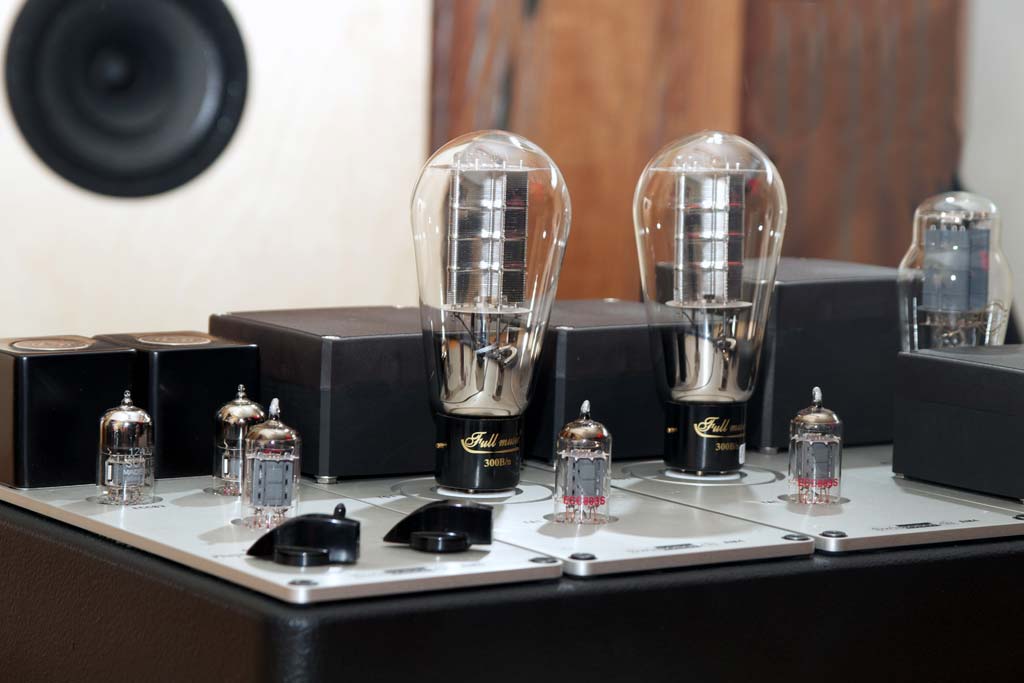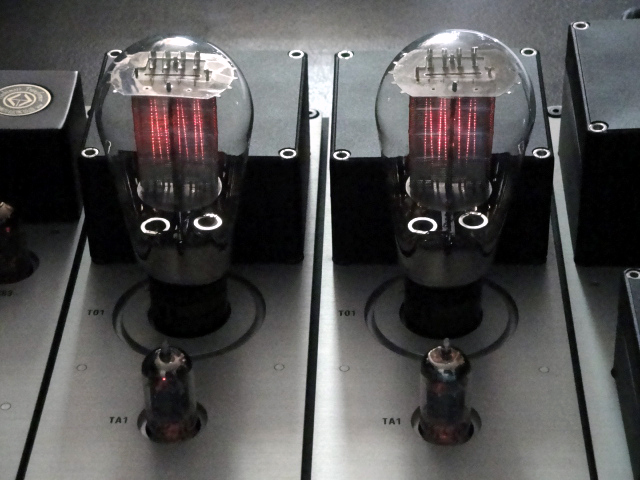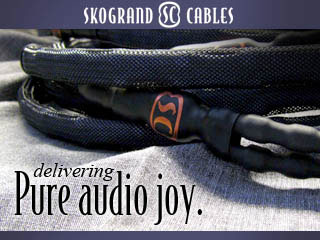Swissonor is a small hi-end company in Geneva, Switzerland. Their first product was a non-magnetic cast iron main platter for the classic Thorens TD124 turntable. They became famous for their mods and improved parts for this beloved turntable. Since then, Swissonor has developed a genuinely complete product range with a single goal of achieving the best sound and performance from analogue sources.
The company’s design goal is to use a single tube and high voltage rectification to power amplifiers and preamps, and to use one directly heated 300B triode in an SET, class A circuit with no negative feedback to produce an illuminated sound and soundstage. They designed the preamp to be optimal for the 300B amp, which must have the AM1 tube rectification module and either the AM5 passive preamp module or the AM6 active preamp module. The review system is based on an AM1 power pack for one preamplifier, an AM6 RIAA phono preamp, Hashimoto HM-3 step-up-transformer, and two AM4 mono amps. The output power is 8 watts as would be expected from a 300B amp. The input impedance is 100k Ohms and the input sensitivity is 600 mV. The AM6 preamp module we have here has a full tube phono stage with two phono inputs, built-in SUTs, and three line inputs.
Other options on configuring their integrated amplifier include a module based on 6V6s (AM2), 6B4Gs (AM3), or the 300B (AM4) module that we have in the review sample.
The frame for these modules is a complex casting of a non-magnetic cast iron alloy. On this very heavy chassis the modules are very securely mounted and wired by hand. The power supply is right on the frame using a heavy power transformer and a GZ34 rectifier tube. The power supplies for the amps and preamp have their own stabilization and filters.
According to Swissonor, the phono preamp is based on the classic Marantz Model 7 using three double triode tubes. It has 43 dB of gain for the MM section and uses a SUT for the MC input.
This is a product that greatly intrigued me. One of the things I like so much about my Shindo Giscours preamp is that it’s a one-box solution for everything but the power amp. It seems the trend with the very best today is to have a two-box line stage and then a two-box phono preamp. With the Swissonor, you get all this and a pair of mono amps in one Chassis; I like it!
System & listening
The Swissonor replaced in my system the Shindo Giscours preamp ($29,000), the Auditorium 23 Homage T1 SUT ($5,000), and the Wavac EC 300B ($29,000). It was used with both the Shindo 301 turntable system and the AMG V12 turntable with a Miyabi Standard cartridge. The speakers were my Teresonic Ingenium XR Silvers. I also used an Auditorium 23 Homage T1 step up transformer between the tonearms and the source input on the Swissonor for comparison sake.
Of course, if all you want is a simple one-box solution that is basically musical, you could just restore a NAD 3020 integrated amplifier. We are looking for more, though. In fact, I’m looking for world class sound from a setup like this and so are the people at Swissonor. So, how did they do?
The reason I own my Wavac EC-300B amp is its glorious midrange and that’s the first thing I listen for. My first impression was very positive about the Swissonor. The midrange was very transparent, alive sounding, and nicely detailed. I also was pleased that after just a few hours of play it was very emotionally involving. I think the midrange is the reason people buy 300B amps. The Swissonor clearly sounded like a SET. The midrange was quite beautiful, and just slightly less immediate- and a little warmer-sounding than my Shindo/Wavac combo. It was a little more like sitting in row M than in row E.
That’s not to say it’s not involving. It is, and very much so. It had a wonderful way of just letting you relax and listen to music. Voices were quite beautiful with good weight and mass to them. It made me feel as if there was a person singing and not just a voice floating in air. It was also emotionally involving, and simply a pleasure to listen to.
The bass is an area where there are many preconceived ideas about 300B amps. Most people think the bass on 300B amps is going to be warm, lacking in punch, and not very deep. This can certainly be the case, but I happen to own a 300B that’s at the other extreme. The Wavac EC-300B has bass that is fast, quick, tight, powerful, and full of air and decay.
I have to admit I wasn’t sure which I would get with the Swissonor. The bass turned out to be just fine: somewhere in between the preconceived ideas and the Wavac. No, the bass wasn’t lightening fast, but it was very good. It reproduced drums, acoustical and electric basses with good impact and a fundamental rightness. This listenable sound of the bass was carried all the way up into the upper midbass without getting fat or boomy. It gives good attacks followed by nice decay.
The top end was open, sweet, and beautiful to listen to. It allowed the music to come to life in a way that sparkled with musical realism. The top end was nicely extended and best of all, it was never analytical or etched.
When it comes to soundstage and imaging, I expect any good system to let the speakers disappear, and for the soundstage to never distract from the enjoyment of the music. My reference system does this extremely well. It floats the image from an imaginary line drawn a foot or so out in front of one speaker to the other, with the soundstage starting there and working its way back. The Swissonar produces a very nice soundstage; not quite as wide or deep as the reference, but very nice. It floats an orchestra very nicely, and instruments do occupy real space with a nice sense of body. The system also had nice scale with the Swissnor in the system.
I like the way it lets me hear the textures of the music and the passion of the musicians. It lets you hear the size of an instrument. You can hear the swell, as a horn gets both louder and larger because the musician keeps putting the horn closer and closer to the mic. The Swissnor did a great job of letting me hear the essence of the music.
Comparisons
Let me start by saying that you can significantly improve the sound of this integrated amp by replacing the Full Music 300B tubes with WE 300Bs, but that will drive the price up even further. You can also not use their SUT but the Homage T1 instead. If you do both of these things, you’ll get a sound that is much closer to my reference system, but still not quite as alive, immediate, detailed, or as quick. Nonetheless, it is an incredible sound. The only problem is, at this point you have raised the price to $22,000, although still less than either the Shindo Giscours or the Wavac EC-300B by themselves. If I was going to spend this much though and to have two boxes and an extra set of interconnects, there is another combo I would want to compare it to: the Allnic T1500 integrated at $6,900 and the Allnic 3000V phono stage at $13,900. In terms of the comparison here, I expect it would be more a matter of taste with the more classic tube sound of the Swissonor compared to the more transparent sound and incredible sound stage of the Allnic products.
Conclusion
This is without a doubt the best integrated amp with a phono section in it that I have heard. If you want great sound and like the simplicity of one box, this is a great choice. It saves you money on interconnects and power cords, too.
- (Page 1 of 1)





Hopefully, this won’t come across as an attack and be removed. I’m just curious- why the fascination with soundstaging? What does this have to do with music reproduction? Maybe Jack can answer here, it would be interesting. Personally, I have heard the Allnic and maybe it does soundstage but I hear no other really interesting sonic traits. So again, maybe Jack can enlighten us to what about soundstage makes him like a product.
Billy
Well, if this doesn’t beat all. I have had two manufactures come to set up their equipment for me to review and were really upset to discover that I listen to mono about 1/3 of the time. Not only that but in my very first review, and most my reviews since I have talked about how unimportant soundstaging is to me. Even in this review I said, “I expect any good system to let the speakers disappear, and for the soundstage to never distract from the enjoyment of the music.”
I do like a good soundstage if it doesn’t distract from the music, but it wouldn’t make my top five of important things about a music system. That said, a lot of audiophiles do find it very important and thus I always feel I should comment about how the product I’m reviewing effects the soundstage.
In regards to the two Allnic products I mentioned, I will let my previous reviews of these two products stand on their own. In both, I compare them to the Wavac and Shindo products, so you can read and decide for yourself. By the way, again in this review I said, “I expect it would be more a matter of taste with the more classic tube sound of the Swissonor compared to the more transparent sound and incredible sound stage of the Allnic products.”
Let me close by thanking you for reading Dagogo and my review. I also thank you for giving me a chance to clarify this if it seemed as if I was elevating soundstaging and it was one of my major priorities; nothing could be further from my intention.
Nice write up. I find it interesting that you did some price comparisons to other products but unless I’m wrong, you fail to mention the price of this amp.
“d”,
The M.S.R.P. is $14,975 for the AM6441 300B Integrated, plus $1,375 for the Hashimoto HM-3 Step Up Transformers, totaling $16,350. This information is available at the top of the Review in the SPECIFICATIONS section. Thank you.
Dagogo Staff
Hi Jack,
Just a point of housekeeping: I am guessing the input impedance should be the 100k Ohm stated in the sidebar rather than 100 Ohm (which would be very difficult for ‘most any source to drive) stated in body of the article.
I don’t think you over-emphasised the sound staging. Although your comment could be taken to suggest that a poor soundstage could detract from musical enjoyment, that is not how I interpreted it.
So, a nice enough amp: attractive, well-built using a conservative and perhaps not as highly-refined design as some at the price point. Possibly a decent value, but I’d want more for that type of outlay.
Regards.
Ray,
Thank you for your readership and email. The oversight on the Line Input Impedance is now corrected.
I would like to chime into this discussion as an owner of a Swissonor 6441 integrated amplifier, which is the subject of Jack Roberts’ review. I find myself in agreement with his analysis, but moreover would like to add that in my experience this unit is absolute dead quiet both with line stage and phono outputs. I replaced a highly regarded phono tube preamplifier with the phono stage of this amp and have no regrets for the exchange.
I do not give great weight to sound staging and other micro dissections but prefer to give greater emphasis to what I will call the Gestalt of the experience, which for me means does it sound like music. I come down decidedly on the verdict that my 6441 does indeed. All that and an amp that lives up to the legendary Swiss reputation for their obsession with quality of construction.
“Ray, have you actually heard a Swissonor product? Like Bob above I own a Swissonor product, albeit the less expensive VSOP integrated with phono. It may interest others to know that I traded in my Shindo to get this piece and the combination with my Devore speakers is beyond words. This thing has real speed, beauty and refinement. I actually did hear the 6441 at my dealer in New York with Swissonor Bach speakers and, like Jack Roberts, agree that it’s the best integrated with phono I ever heard. Words such as soundstaging just don’t come to mind when listening to it because it’s so compellingly musical and Jack makes that clear. Swissonor seems to be all about refinement but at the same time it is so quiet and fast. I’m not sure why the Allnic comparison was thrown in there but I can’t imagine the Allnic coming even remotely close to these Swiss made gems in terms of the “gestalt” that Bob and most experienced listeners (like Jack Roberts) admittedly look for.
I threw in the comparison to the Allnic because it’s an alternative view of how to play back audio. Both are valid ways, and many audiophiles and music lovers are looking for that sound where others are looking for what Harvey refers to as a “gestalt” experience.
I’d love to know which Devore speakers Harvey has. I own the 88’s, but fear that 8 watts may not be enough to produce the gestalt effect.
Great site Jack, and nice review.
Andrew